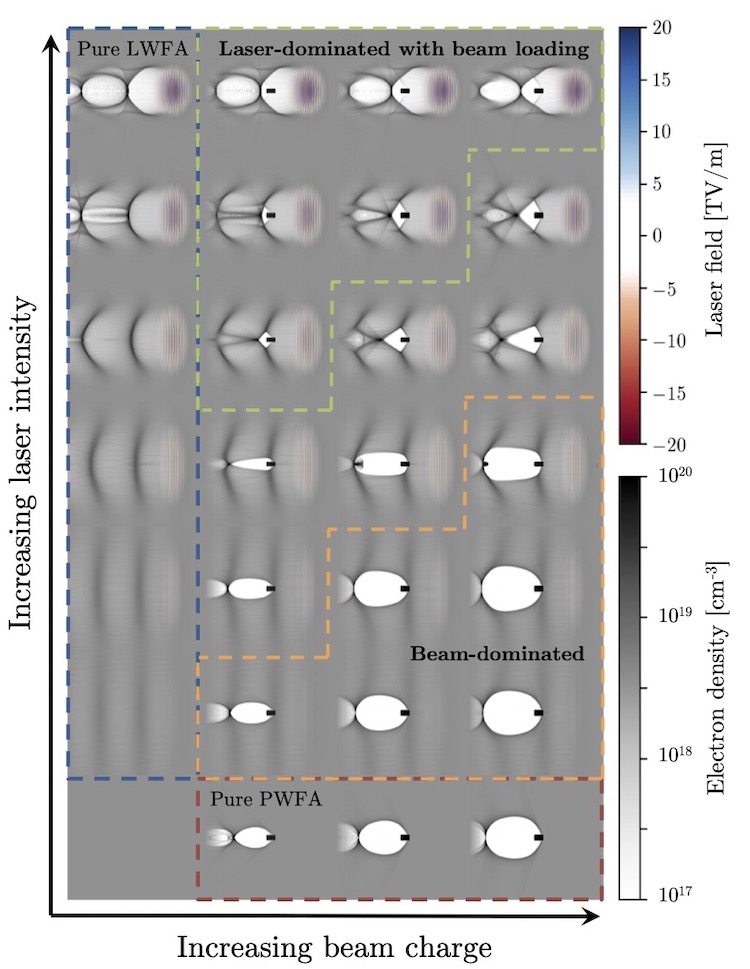New Paper published in Physical Review X
Physics of High-Charge Electron Beams in Laser-Plasma Wakefields
21.10.2020
High-energy particle accelerators are of immense importance in medicine and basic science alike. However, their size and cost restrict the operation of such machines to a few large-scale laboratories worldwide. So-called “wakefield” accelerators may in the provide a route to a new and considerably more cost-effective accelerator technology, as the strength of their acceleration fields surpasses those of conventional accelerators by orders of magnitude. This promises to make them correspondingly smaller and cheaper. For instance, the GeV energy frontier, normally requiring a 100-m long conventional accelerator, can now be reached with an acceleration length of only 1 cm.
These immense acceleration fields are generated in a plasma medium by either an intense laser pulse (so-called “laser-wakefield accelerator” or LWFA) or a dense relativistic particle bunch (“particle wakefield accelerator”, PWFA). A new generation of intense lasers and advanced injection techniques allowed us to increase the bunch charge of LWFAs by a factor of 10 to 100 compared to most previous experiments. These high-charge bunches permit studying in detail the so-called beam-loading regime, where the electron bunch self-fields rival or even surpass the acceleration fields. The resulting strong modulation of the acceleration fields has a profound impact on the acceleration dynamics and affects the quality of the electron bunches in both positive and negative ways. With the large parameters space afforded by the highest available LWFA bunch charges we were able to study beam-loading and its effects in detail for the first time and understand its subtleties by comprehensive numerical simulations.

Figure: Simulations illustrating different regimes of laser- and beam-driven plasma wakefield acceleration, including the mixed regimes of beam-loaded laser wakefield acceleration and beam-dominated laser-plasma wakefield acceleration.
By comparing experimental data sets taken at different laser facilities, we demonstrate that beam-loading is a universally scalable phenomenon, and has to be taken into account for efficient LWFAs and PWFAs regardless of the driver power. The modulation of the accelerating fields by the main bunch charge was directly probed by a second (witness) electron bunch, injected at different positions in the plasma wave in a controlled manner. We could also show that after depletion of the driving laser, the highly charged first bunch can act as a PWFA driver and dominate the wakefield generation. In that case, the witness bunch extracts energy from the bunch-driven wakefield, making this scheme to become a hybrid staged LWFA-PWFA accelerator, which in the future may help to overcome some key limitations of both approaches.
With this work, we could open the door for a better understanding of the dynamics of such novel accelerators, which will hopefully help to boost their wider dissemination.
Original Publication
- J. Götzfried, A. Döpp, M. F. Gilljohann, F. M. Foerster, H. Ding, S. Schindler, G. Schilling, A. Buck, L. Veisz, and S. Karsch, "Physics of High-Charge Electron Beams in Laser-Plasma Wakefields", Phys. Rev. X 10, 041015 (2020)

